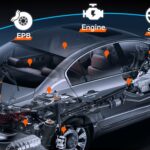The 1995 Corvette often sparks confusion when it comes to its onboard diagnostics system. Many owners and enthusiasts find themselves asking: is the 1995 Corvette OBD1 or OBD2? This question arises because the 1995 model year exists in a transitional period, leading to a system that’s not quite either, but a unique blend of both. Let’s clarify the specifics of the 1995 Corvette’s diagnostic setup.
To understand the situation, it’s important to know that 1995 was a pivotal year for automotive diagnostics. While OBD2 became mandatory in 1996 for all cars sold in the US, General Motors, including Corvette, began implementing aspects of OBD2 earlier. Starting in 1994, the Corvette adopted the 16-pin Diagnostic Link Connector (DLC), the connector type universally associated with OBD2. This was a shift from the 12-pin DLC used in Corvettes from 1982 to 1993.
However, despite having the OBD2 connector, the 1994 and 1995 Corvettes did not possess full OBD2 functionality in the way we understand it today. Instead, these models featured a partial OBD2 capability. This means that while they physically used the OBD2 connector, the diagnostic system was primarily designed to function similarly to the older OBD1 systems in terms of triggering the Malfunction Indicator Lamp (MIL), commonly known as the “check engine light.”
The primary reason for incorporating these early OBD2 elements was for General Motors to gain real-world experience with the OBD2 system before it became a legal requirement. When a 1994 or 1995 Corvette came in for service with an illuminated MIL, technicians were instructed to not only address the issue triggering the light but also to use advanced scan tools to observe how the partial OBD2 system reacted to the problem. This allowed GM to gather valuable data and refine their OBD2 implementation for future models.
Crucially, the OBD2 functions in the 1994 and 1995 Corvettes would not independently activate the MIL. Only the more basic diagnostic functions, akin to what was standard in OBD1 systems from 1982-1993, were capable of turning on the check engine light. Furthermore, unlike true OBD2 systems, the 1994 and 1995 Corvettes do not display powertrain Diagnostic Trouble Codes (DTCs) by flashing the check engine light in any specific pattern.
When it comes to using scan tools, owners of 1995 Corvettes need to be aware of potential limitations. Many inexpensive, basic OBD2 scanners may not fully access the diagnostic information available in these transitional models. These budget-friendly scanners are often designed primarily to read powertrain-related codes and may not support diagnostics for chassis or body control computers. Therefore, they might not be able to retrieve ABS/ASR (Anti-lock Braking System/Acceleration Slip Regulation) codes, for example.
For comprehensive diagnostics, especially concerning systems beyond the powertrain, consulting the factory service manual for the 1995 Corvette is highly recommended. This manual contains detailed instructions on how to read fault codes from systems like the ABS controller and provides the correct diagnostic procedures for resolving these issues. The instrument panel (IP) display itself can also be used to access some DTCs set by the chassis and body computers, as outlined in the service manual.
In conclusion, while the 1995 Corvette features an OBD2 style 16-pin connector, it operates with a hybrid diagnostic system that leans heavily towards OBD1 functionality. It was an early step towards OBD2, primarily implemented for manufacturer testing and data gathering. For practical diagnostic purposes, particularly for DIYers using standard scan tools, understanding that the 1995 Corvette is not a fully OBD2 compliant vehicle is essential. For complete and accurate diagnostics, especially for systems beyond the engine and transmission, relying on the factory service manual and potentially more advanced scan tools is advisable.
